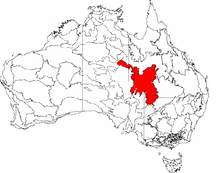Channel Country
The Channel Country is a region of outback Australia mostly in the state of Queensland but also in parts of South Australia, Northern Territory and New South Wales.[1][2] The name comes from the numerous intertwined rivulets that cross the region, which cover 150,000 km².[3] The Channel Country is over the Cooper and Eromanga geological basins and the Lake Eyre Basin drainage basin. Further to the east is the less arid Maranoa district.



Geography
Birdsville and Windorah are the most prominent towns in the area. Other settlements include Betoota and Bedourie. Haddon Corner is also located in the Channel Country. The Channel Country is the location for a majority of Min Min light sightings. It is also home to at least two important bird areas, Lake Yamma Yamma and the Lake Machattie Area.
The Channel Country features an arid landscape with a series of ancient flood plains from rivers which only flow intermittently. The principal rivers are Georgina River, Cooper Creek and the Diamantina River. When there is sufficient rainfall in their catchment area these rivers flow into Lake Eyre, South Australia. In most years the flood waters are absorbed into the earth or evaporate, however. One of the most significant rainfall events occurred in 2010 when a monsoonal low from ex-Cyclone Olga created a period of exceptional rainfall.[4]
Land use
The primary land use is cattle grazing which has replaced sheep grazing.[5] It is estimated that in the Queensland section alone there are between half to one million head of cattle.[6] The area's towns and cattle stations are serviced by a mail run that is operated by West Wing Aviation which delivers goods and passengers as well as mail.[7]
In 2013, the Queensland Government placed caps on water extraction from the region's river to prevent the introduction of cotton growing. At the same time open-cut mining was banned but coal seam and underground mining have been permitted after changes were made to the Wild Rivers legislation.[8]
Bioregion
The Interim Biogeographic Regionalisation for Australia Channel Country Bioregion covers a larger area, extending into South Australia, the Northern Territory and New South Wales and includes the town of Innamincka.[2]
History
Indigenous Australians have inhabited the area for approximately 20,000 years, with over 25 tribal groups living in the Channel Country area. A vast trade network had been established running from north to south with goods such as ochre sent north with shells and pituri moved south. Birdsville was once a major meeting place for conducting ceremonies and trade.[9]
Innamincka Station was established in 1872 by Robert Bostock and grew until it covered over 15,000 square kilometres (5,792 sq mi) and in 1881 it supported a herd of 8,000 cattle.[10] It the first station and permanent settlement set up along the Cooper Creek.[11] The tender was accepted for the run named Caryapundy by J. C. Myers in 1872. Myers was also had his tenders accepted for other runs such as Bollwarry, Mount Wood, Teriwinda and Torrens Creek.[12]
Annandale Station was established when Patrick Drinan took up the run in July 1876. Other properties were settled soon afterward including Kaliduwarry and Glengyle Stations.[13] Pandie Pandie Station was established in the same year by Robert Frew[14] as was Alton Downs and Planet Downs.[15] Nearby Haddon Downs station was also taken up by Frew in 1877.[16] Diamantina Lakes Station was also established in 1876 with a partnership between John Arthur Macartney and Hugh Louis Heber-Percy who initially took up the lease.[17]
Birdsville was originally known as Diamantina Crossing from 1881.[18] but by 1882, the current name was in common use[19] and was formalised at the proclamation of the town in 1887.
References
- Channel Country Bioregion New South Wales Department of Environment, Climate Change and Water.
- "Rangelands – Overview – Channel Country". Australian Natural Resources Atlas. Department of the Environment, Water, Heritage and the Arts. Archived from the original on 5 October 2009. Retrieved 11 September 2009.
- Reardon, Mitch (1995). The Australian Geographic Book of Corner Country. Terrey Hills, New South Wales: Australian Geographic. p. 93. ISBN 1-86276-012-8.
- "Channel Country rain will boost cattle feed". ABC Rural. Australian Broadcasting Corporation. 3 February 2010. Retrieved 18 May 2010.
- "Boulia: Capital of the Channel Country". Boulia Shire Council. Retrieved 18 May 2010.
- Ben Lynes (August 2007). "Focus on the Channel Country". The State of Queensland. Archived from the original on 25 July 2010. Retrieved 18 May 2010.
- "West Wing Aviation Mail Runs". Archived from the original on 4 September 2012. Retrieved 12 September 2008.
- John McCarthy (31 July 2013). "Coal seam gas, underground mining get green light in Queensland western river catchments". The Courier-Mail. News Limited. Retrieved 2 June 2014.
- "Georgina-Diamantina Catchment Strategic Plan" (PDF). Natural Heritage Trust. 1 October 2000. Archived from the original (PDF) on 29 October 2013. Retrieved 26 October 2013.
- "Innamincka". Flinders Ranges Research. 2012. Retrieved 14 May 2016.
- Reardon, Mitch (1995). The Australian Geographic Book of Corner Country. Terrey Hills, New South Wales: Australian Geographic. pp. 91–108. ISBN 1-86276-012-8.
- "Government Gazette". The Empire. Sydney, New South Wales: National Library of Australia. 11 December 1872. p. 2. Retrieved 16 June 2013.
- S.E. Pearson (1937). "The South West Corner of Queensland" (PDF). University of Queensland. Retrieved 14 May 2016.
- "Diamantine Shire History". Diamantina Shire. 2012. Archived from the original on 3 May 2013. Retrieved 9 June 2013.
- "Birdsville". The Sydney Morning Herald. 8 February 2004. Retrieved 9 June 2013.
- S. E. Pearson (1937). "The South West corner of Queensland" (PDF). University of Queensland. Retrieved 9 June 2013.
- "Obituary". The Brisbane Courier. Queensland: National Library of Australia. 8 April 1925. p. 12. Retrieved 2 May 2013.
- "Birdsville". Queensland Holidays. Tourism Queensland. Retrieved 11 March 2012.
- "The far north". The Sydney Morning Herald. National Library of Australia. 19 August 1882. p. 9. Retrieved 11 May 2014.